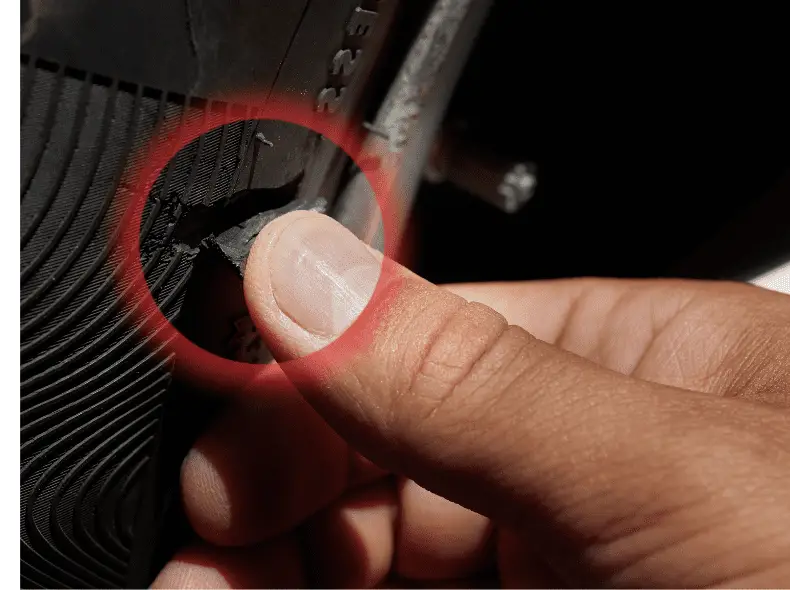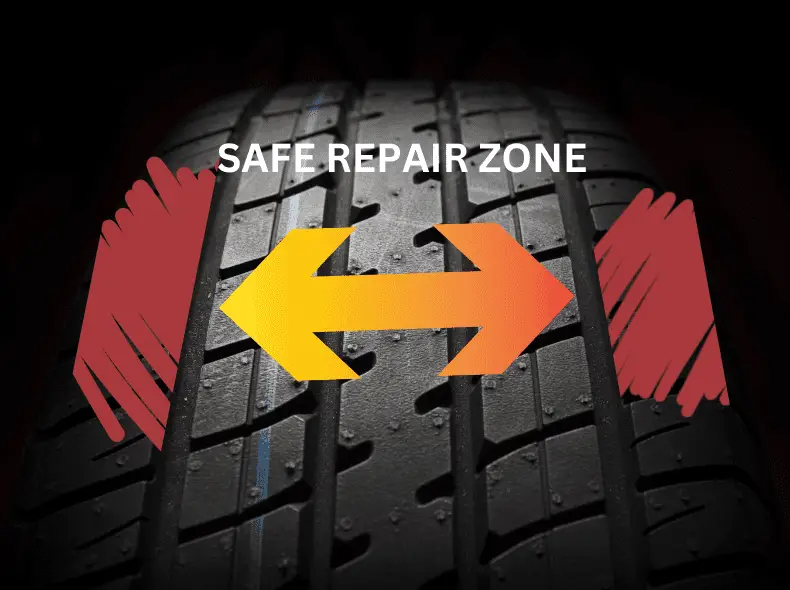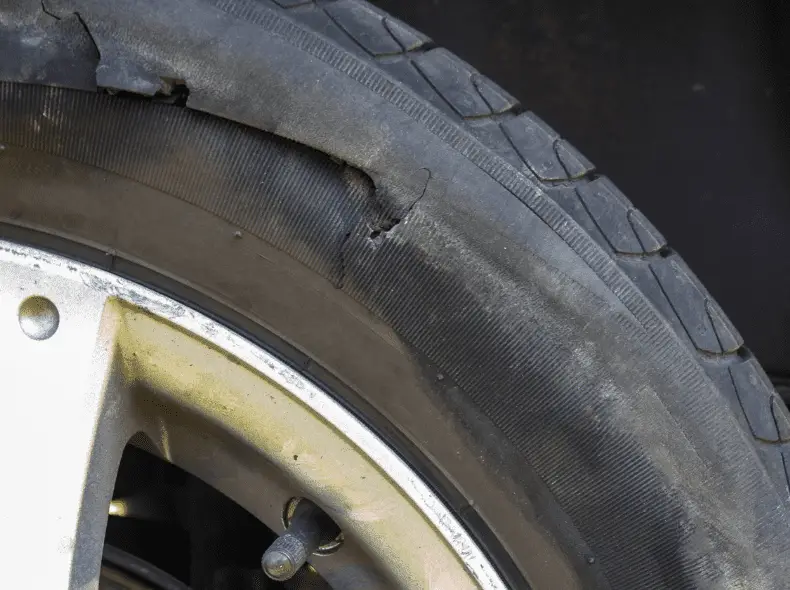I hate to be the bearer of bad news, but any hole in the sidewall of a tire cannot be repaired.
Don’t be tempted to patch or plug the tire, as you could be putting yourself and others at risk. If you take a tire with a damaged sidewall to a tire shop, they will not touch it and tell you you need a new tire.
Why Can’t Tires With A Damaged Sidewall Be Repaired?
Although the tire tread grips the road and disperses rainwater, it doesn’t support the tire’s weight on your wheel rim.
That job falls to the sidewall. The sidewall is often overlooked in its importance to the tire. We are always told to look for signs of wear on the tire tread and to replace it when it goes below 2 / 32 inches.
Of course, the tread is very important, but the sidewall is critical too.

The sidewall doesn’t have steel belts helping to keep it taut and in shape. The sidewall relies totally on air pressure to retain the tire’s rigidity. A hole in the sidewall adversely affects this. Also, the patching process doesn’t work as well on pure rubber areas with no belts or cords.
It can’t be more heavily reinforced as it needs to be supple to flex as you go over bumps in the road. If the sidewall didn’t flex, it would mean an extremely hard ride.
This is why sidewalls are treated extremely carefully, and any sign of holes in it means the tire has to be replaced.
Even scuffing a sidewall against the curb should be investigated further by a tire shop. They will take the tire off the rim and inspect the inside sidewall for damage.
Any sign of it being out of shape or dented will mean they will recommend a brand new tire.

If you drive on a flat tire, the sidewall is likely to be compromised
When you have a flat tire and no way of repairing it, the temptation is to limp home or to a tire shop with it and sort it out then.
Even if the tire wasn’t damaged before you got the flat, it is now. The sidewall will inevitably collapse due to no air pressure to maintain it and come into contact with the road.
This will cause irreparable damage to the tire sidewall structure.
As you re-inflate the tire, you will see that the sidewall appears to be scuffed around a certain area of the circumference.
This is the area that has been in contact with the tarmac. The tire now needs to be replaced.
Tire Sidewalls Are More Likely To Blowout
Most people become fixated on checking the tread of their ties and neglect the sidewall completely. It has been drummed into us that tire tread keeps us safe on the road, but little is said about the sidewall.

Tire sidewalls only have air pressure to support them, whereas the tread has steel belts and cords to assist.
Due to this, any hole in the sidewall is likely to rip further as the high-pressure air tries to escape quickly into the atmosphere.
Popular related articles: Can A Nail In A Tire Cause A Blowout? [ANSWERED]
What Are the Main Causes of Damage To A Tire Sidewall?
- Wrong Air Pressure
Tire pressure that is too high or too low is often overlooked when it comes to sidewall failure.
Too much tire pressure can cause the bead to come away from the rim and rapidly decompression. Too little in your tire can cause the sidewall to come into contact with the road and scuff it, damaging it beyond repair.
- Potholes and Curbs
Both potholes and curbs can cause impact damage to your tire sidewall. Whereas your car’s chassis has shocks and struts to cushion the impact of curbs, especially potholes, your tires do not have this.
The force of any sudden Impact on the sidewall of the tire remains in the area and doesn’t get dissipated elsewhere.
- Screws and Nails
Screws and nails are the bane of a tire’s life. Usually, when your car is damaged, there is a guilty party to claim off an insurance policy.
With screws and nails on the road, there is no such compensation, and finding a nail or screw in your tire can be extremely frustrating.
I have experienced a screw or nail four times in my thirty plus years of driving. Strangely three caused a hole in the sidewall and only one in the tread. I was not driving in an industrial area or one where houses were being built.
All four happened in normal urban driving, and I can only assume another car tire picked them up and threw them in my direction.
In any case, all three tires with the sidewall damage were replaced, and the other tire with the nail in the tread was repaired with a patch.
- Poor Manufacturing Processes
All tires are made to minimum standards. However, some brands are still made to a higher standard than others.
Generally, although more expensive, the well-known manufacturers have put their tires through a much tougher regime, and the standards and manufacturing plants are higher.
- Old Age and Dry Rot
Most manufacturers recommend that their tires are not used after ten years. As most of us will drive way in excess of the treads lifetime in miles way before ten years is reached, it isn’t normally an issue.

Sometimes due to chemicals on the road, tires can prematurely age and crack. The smaller cracks you see are normally weather cracks caused by sunlight and are nothing to worry about.
It’s the deeper, longer cracks that should cause concern. The tire’s integrity could be compromised, and the tire unroadworthy. These cracks can lead to tread separation.
- Vehicle Overloading
Every tire has a load rating that shouldn’t be exceeded. The manufacturer’s load rating is given after the tire has been put through rigorous testing.
Although car handbooks often say a car tire can be inflated with more air for heavier loads, there is a limit to this.
You can’t exceed the PSI limit stated in the handbook for heavy loads. This could cause the rim to separate from the side wall or, if you go over a pothole, cause the excess pressure to force its way through, causing a blowout.
In Conclusion
Damage to a sidewall or tire shoulder cannot be repaired. The shoulder section is the part between the sidewall and the large tread area at the center of your tire.
This tire area has no strengthening from cords or steel belts.
If you have a scuff on the sidewall from a curb impact, you should get the tire removed by a car shop, and the interior sidewall inspected.
Other than superficial small shallow cracks, any sidewall cracking should also be looked into. Never under or over inflate your tires and make sure you don’t exceed the load rating on the tire as well.



![How Long Do New Tires Take To Put On? [ANSWERED] Torque-wrench-tire](https://carzaza.com/wp-content/uploads/2023/12/Torque-wrench-tire-300x150.png)
![Will A Bent Rim Cause Vibration? [ANSWERED] Damaged-rim](https://carzaza.com/wp-content/uploads/2023/12/Damaged-rim-300x155.png)
![Will A Cracked Rim Leak Air? [NOT ALWAYS] Tire-blowout](https://carzaza.com/wp-content/uploads/2023/12/Tire-blowout-300x224.png)
![How Much Do Car Tires Weigh? [ANSWERED] summer-tires](https://carzaza.com/wp-content/uploads/2024/02/summer-tires-300x150.png)
![Tire Plug Vs Patch Cost [ANSWERED] tire-patched](https://carzaza.com/wp-content/uploads/2023/12/tire-patched-300x224.png)





